"Spiral" development of aerospace systems

Exactly 40 years ago, after separating from the Tu-95KM aircraft carrier, the MiG-105.11 went to its first solo flight and received the nickname “bast” for its characteristic form. It was an analogue of the orbital spacecraft, created as part of the aerospace system "Spiral" along which the accelerating plane was also capable of being developed at 6M speed and two rocket stages for launching the spacecraft into orbit. As a result, only the ship was made and several copies of it at a scale of 1: 3 that flew into space. Despite this, the "Spiral" and the American project X-15, which came from the 1960s, were the closest to the end of all the projects for the air launch of space cargo at the moment.
Difficulties in creating an engine for a hypersonic propeller ( scramjet ) and chronic bad luck pursued such projects. And even now, when the seemingly appearance of the first workers of the scramjet ( X-43 and X-51 ) opened the way to space for such projects, the appearance of reusable first steps (from SpaceX , Blue Origin and India ) seems to be finally going to put fat on the history of these projects the point. What did it bother them all the time? This will be discussed below.
')
Theory
What is so advantageous air start? The fact is that it allows saving in the mass of the rocket due to the fact that part of the speed and height are covered by the spreader plane (that is, it reduces the required reserve of the characteristic speed or delta-V), also it allows you to put right on the first rocket stage of LRE with vacuum nozzles which have a greater specific impulse , which increases the efficiency of the engine and also reduces the weight of the rocket. At the same time, aircraft engines, such as turbojet ( TRD ), direct-flow ( RAMJET ) and even hypersonic ( scramjet ), although they have a specific impulse, falling with increasing speed, but it still remains significantly higher than the LRE up to 10 speeds of sound ( 10M ):

In addition, until 1993, the landing of the rocket stage on the engines seemed too complicated and was not considered as a promising direction for reusable space systems. So the vast majority of reusable projects up to this point in one way or another relied on the concept of a design with wings or a bearing body and a horizontal landing.
Comparison of the benefits of the air start from the maximum speed of the spreader:
| Separation rate | 0.75M | 2.5M | 3.1M | 6M |
|---|---|---|---|---|
| Separation height | 9 km | 20 km | 22 km | 26 km |
| Required delta-V | 8.51 km / s | 7.49 km / s | 6.47 km / s | 5.59 km / s |
| Delta-V Percentage of Land | 92% | 82% | 78% | 67% |
It would seem that subsonic start allows you to save quite a few (up to 10%) - but in this case several problems appear at once: in order to get the maximum benefit at the start with a limit of ≤1M we need to climb as high as possible. But due to the drop in air pressure at the height, the stall speed (minimum speed) of our aircraft begins to increase, while the speed of sound (maximum speed), on the contrary, begins to fall. The most indicative of this planet was the Lockheed U-2 reconnaissance aircraft, which climbed to an altitude of 21 km. With a cruising speed of 805 km / h, it had a safe speed window of just 19 km / h (after upgrading the aircraft, its safe window weight became even smaller), the exit from which threatened to stall into a corkscrew or even destruction of the aircraft. This schedule of safe values converging with an increase in altitude at one point gave the pilots a very colorful name “end of the corner” - partly because three test pilots died during the tests of the aircraft because of this effect. For a strategic intelligence officer, such a danger could be tolerated, but for an ordinary commercial “space driver”, this turns out to be an excessive risk.
Thus, all modern projects of air launch are limited to the practical ceiling of transport aircraft, usually 10-12 km. At this altitude, the LPRE vacuum nozzle still has significant losses in efficiency, which means a slower start and greater losses at the time of the launch of the rocket (when the loss share is already the most). Thus, we need to either use engines specially developed for such large elevation changes or to make an engine with an "intermediate" nozzle. This forces us to actually make a specialized launch vehicle for an air launch that will not be unified with ground samples, or use the currently existing components of ground launch missiles that are not optimal for an air missile and thus lose a significant part of its advantages.
Previous projects:
Rocketplane X-15

It was dropped from under the wing of one of the two B-52 bombers allocated for this purpose at an altitude of 13.7 km at a speed of about 800 km / h. After that, the rocket glider launched its LRE on ethanol / oxygen components and, depending on the flight plan, gained the maximum height or speed, then planned to the bottom of the salt lake and landed on the front wheel rack and two rear skis. In total there were three rocket-planes: 1) X-15-1 - the basic model which made 82 flights; 2) X-15A-2 - the version which made a total of 53 sorties, on which additional drop tanks and ablative protection were installed during the flights, through which William Knight was able to reach a speed of 7,247 km / h in flight No. 188; 3) X-15-3 - the version used for high-altitude flights, on flights 90 and 91 Joseph Walker was able to climb to an altitude above 100 km — beyond the generally accepted boundary of space ( the Karman line ); no one managed to do this for 199 flights 3 rocket gliders.
Flights continued from June 8, 1959 to October 24, 1968, after 6 transfers of the 200th flight due to various reasons, it was canceled along with the entire program on December 20, 1968. In flight number 4 on November 5, 1959, Scott Crossfield had to crash because of a small fire. The X-15-1 rocket glider not designed for landing with full tanks broke, but the pilot was not injured. It took 2.5 months to repair the damage. In flight No. 74 on November 9, 1962, the X-15A-2 rocket-plane engine could not reach its full capacity, due to which it was decided to land in an unplanned place and with exceeding the limits for mass and speed, which caused the rocket glider to land on fire. , pilot John McKay suffered serious injuries. The X-15-3 rocket launcher was completely lost in flight No. 191 on November 15, 1967, when he entered the atmosphere when he entered the atmosphere, the pilot Michael Adams died. Both of the remaining X-15s are on display in museums.

The X-15 could hardly reach the cosmos (which New Glenn is now starting off easily), since its fuel was far from ideal, having a specific impulse of only 276 seconds. This allowed the rocket plane to have a reserve of the characteristic speed of 2.4 km / s - much less than the minimum required for going into orbit of 7.8 km / s. But for this problem there was an elegant solution: it was supposed to develop deltoid wings designed for high speeds for the X-15-3 rocket plane, and the rocket plane was going to launch with an additional rocket stage from the back of the XB-70 strategic bomber Valkyrie. New wings for the rocket glider were blown through the wind tunnel from 1966 until the X-15-3 crash put an end to this idea.

The flight tests of the two built Valkyries proceeded normally until October 14, 1965, when the first sample, when tested at a speed of> 3M, had a free-flowing air stream from the left wing 60 cm of its honeycomb structure. It was decided to limit the speed of this prototype to M = 2.5. With joint demonstration flights of the second type of the Valkyrie and the F-104 Starfighter, on July 8, 1966, the latter sucked and struck the wing of the Valkyrie in a turbulent flow. Pilot F-104 Joseph Walker (who set the height record for X-15) died on impact, the Valkyrie fell into a flat corkscrew from injuries received and broke, one of its two pilots could not eject and also died.
The flights of the remaining Valkyries continued until February 4, 1969, with speed limits, until this project was completely closed by then Defense Minister Robert McNamara, along with another remarkable project, the space plane X-20 Dinozavr .

In parallel with the dropping of rocket planes “Stratospheric Fortresses” B-52 participated in the testing of NASA devices with a carrying case called for their shape and mediocre aerodynamics “flying bathrooms” - ships of the M2-F1 , M2-F2 and M2-F3 series (center). As Milton Thompson spoke about this aircraft: “if a man fell out of the B-52 at the time of the separation of the M2-F1 from the aircraft, then the device would have outstripped him from the Earth.” In the future, aerodynamics improved, thanks to which HL-10 (right) and X-25A (left) appeared, but all these devices had only small engines and were intended solely for aerodynamics research during descent from orbit, which ultimately formed the basis of the “Space Shuttle . So a record for all three vehicles were the results in 1976 km / h in speed and 27,524 m in height shown on the HL-10 in flights on February 18 and February 27, 1970, respectively.
"Spiral"
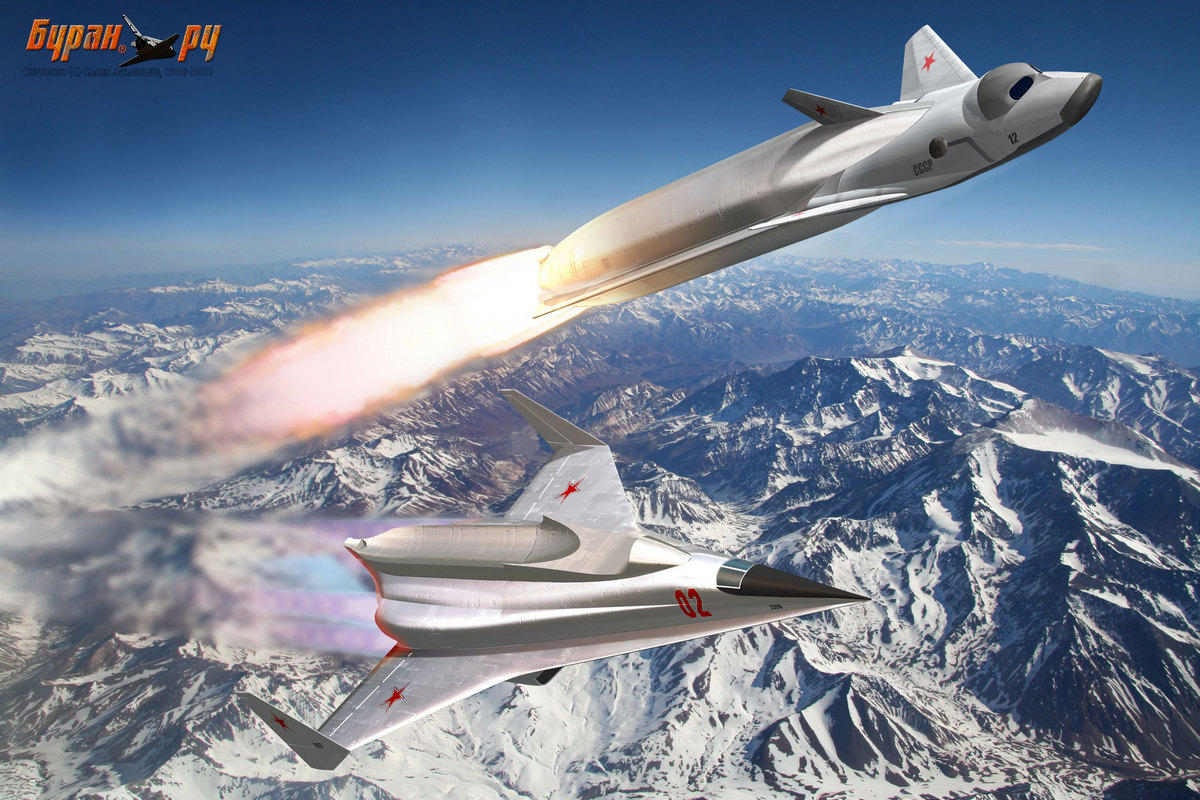
The heart of the program was to be a hypersonic accelerating plane, which was supposed to develop 4-6M. At the beginning, they wanted to entrust this project to the Tupolev Design Bureau (the Tu-144 already engaged at that moment), but in the end he refused it. The project adopted the Mikoyan Design Bureau, which conducted the flushing of aircraft models in a wind tunnel until the project was closed. The accelerating aircraft accelerated with a help of a booster car to a speed of 400 km / h, after which it started its engines and took off from the ground. To improve aerodynamics after takeoff, the nose of the aircraft was raised, thereby limiting the review to the bottom - this option was used on the Tu-144 and the Concorde , and for the Soviet bomber the T-4 went even further and made the cockpit completely closed.
Since the base fuel for the rocket stages (fluorine / hydrogen) and the fuel for the scramjet of the spreader aircraft (hydrogen) had not been used for this purpose before, it was decided at the initial stage to develop an intermediate version of the system with somewhat worse indicators. However, even this intermediate version should have become in many respects the best that was created before, and the main version of the system is completely amazing:
| Specifications | Intermediate option | Main option |
|---|---|---|
| Spreader Fuel | kerosene | hydrogen |
| Fuel boosters | oxygen / hydrogen | fluorine / hydrogen |
| Spreader speed | 1200 m / s (4M) | 1600 m / s (6M) |
| Compartment height | 22-24 km | 28-30 km |
| Takeoff weight (total) | 130 tons | 115 tons |
| Ship weight | 6.8 tons | 8.8-10.3 tons |
| Payload mass | - | 0.5-2 tons |
Despite the simultaneous start of the construction of the spreader, engines for it and the orbital ship, the engine was not ready for the project closure in the early 70s, and the accelerator models continued blowing until 1975, and only on April 25 of this year (after the official closure of the project) -analogue MiG-105.11 was transferred from the manufacturer for testing. Since the ship had a military orientation, it was assumed that the cockpit would be shot, to have its own engines and a parachute for the possibility of independent descent from orbit and landing on the ground. Due to common problems with the project, this part of the ship was never implemented.
The first aircraft analogue of the MiG-105.11 was dropped from a Tu-95KM in its 11 joint flight on October 27, 1977, after which the runway Groshevo landed. The analog tests were carried out until September 13, 1978, when the pilot blinded the Sun due to an error of the flight leader during an approach at the wrong course, in the evening, resulting in a hard landing that damaged the chassis. On October 24, the aircraft was sent on a suspension of the same Tu-95KM to the Tushinsky engineering plant for repair. Although the analogue aircraft was later repaired, this flight on the TMZ remained the last for the MiG-105.11.

After the official closure of the project, hope remained for using the orbital ship of aircraft from other projects to launch, most of all, the T-4 project of the Sukhoi Design Bureau, which has an interesting history, was most suitable for this role. Since the USSR did not have the opportunity to create such a large number of carrier groups as the United States had, it was necessary to find some other way to fight them. Conventional nuclear weapons were not suitable for these purposes, since in the time between receiving information about the position of the aircraft carrier and the missile’s upshot, it could go out of range. Therefore, it was proposed for this purpose to create a small group of strategic bombers with nuclear missile weapons.
The calculations showed that in order to break through the air defense of an aircraft carrier connection, they had to have a very high speed - about 3M. Three design bureaus participated in the competition: the Tupolev Design Bureau with the Tu-135 project, the Yakovlev Design Bureau with the Yak-35 project and the Sukhoi Design Bureau with the T-4 project. As a result, the Sukhoi Design Bureau won the project, while Sukhoi and Tupolev himself fell out at the same time, which led to their famous conversation when discussing the future of this project:
Tupolev: “Sukhoi is my student, I know him — he will not cope with the topic.”As a result, one copy of the T-4 was nevertheless built and tested until the transition to supersonic, but due to the fact that Tupolev eventually managed to ensure that new T-4 samples were not produced at the Kazan Aviation Plant , the project in eventually slowed down and was soon closed.
Sukhoi: “It is because of Andrei Nikolayevich that I am your student, I will cope with it.”

For further testing of the orbital spacecraft, the MiG-105.12 has already been manufactured (for tests on supersonic sound) and have begun construction of the MiG-105.13 (already for tests on hypersound). Both of these analogs were not completed until the end of the construction of Buran, when their construction was completely minimized, while the third analog was still being tested in a thermal pressure chamber while the second simply stood on the TMZ until the late 1970s. Now the only flying instance of the MiG-105.11 is in the Central Museum of the Air Force in Monino, side by side with the T-4 and the supersonic passenger Tu-144 (the story of which was not much luckier).

Another very interesting point: Gagarin defended his diploma on February 17, 1968, the theme of his thesis was a spaceship with lattice rudders (like those that are now used on reusable rockets of the Falcon 9 family ). In the future, this direction was to be the topic of his PhD work. Yury Alekseevich died on March 27 of the same year in his graduation flight with an instructor, in which he, after a long break in the flights, had to get the right to fly again ...

MAX
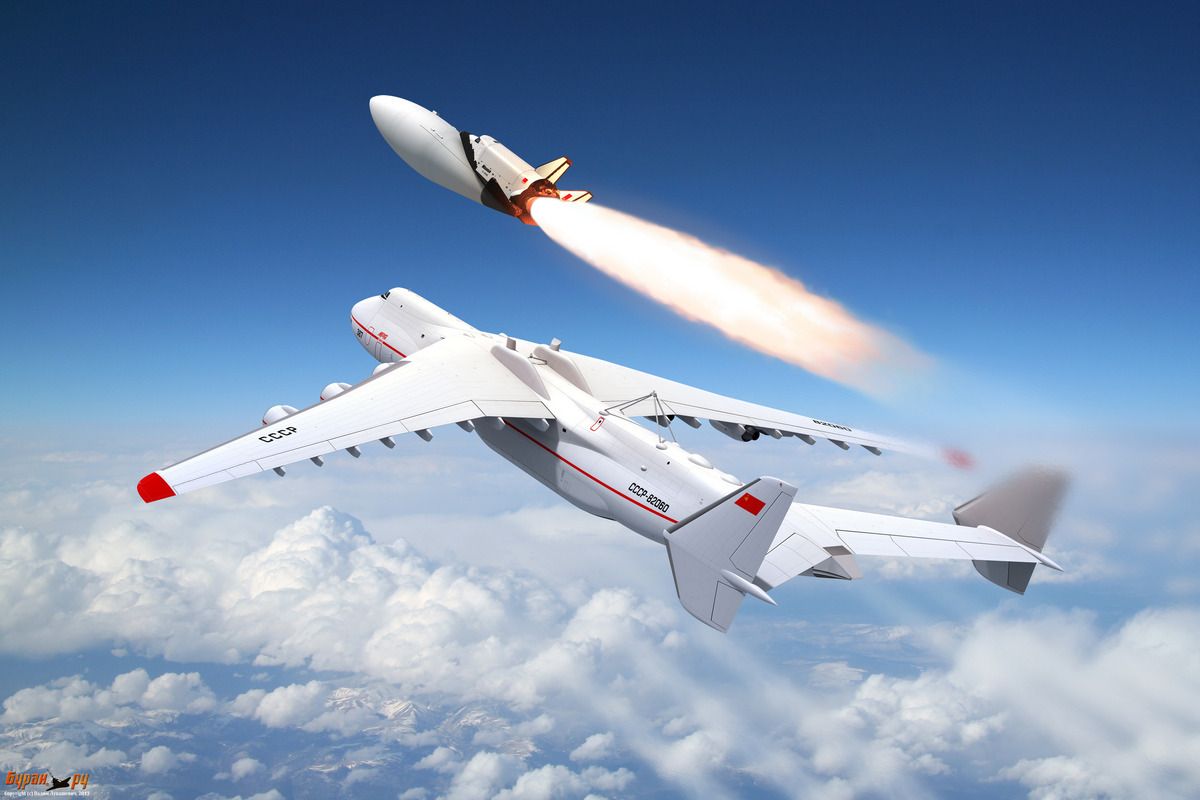
The project envisages starting from AN-325 (an enlarged version of the AN-225 , built to transport the Buran, the central tank of the Energia launch vehicle and other oversized cargo weighing up to 250 tons, which it can carry inside the fuselage or on an external suspension). The construction with a total weight of 275 tons including a tank, an orbital ship and 7 tons of payload had to go into orbit thanks to a unique RD-701 two-chamber engine working on kerosene + hydrogen / oxygen components of the fuel. The engine had two modes: in the first of them, to increase thrust, both chambers were supplied with a large proportion of kerosene (which provided 2.5 times more thrust), while the engine later switched to the second mode in which the kerosene supply was completely stopped (providing 10 % greater specific impulse):
| RD-701 | 1st mode | 2nd mode |
|---|---|---|
| Traction | 408 | 160 |
| Specific impulse in vacuum, s | 415 | 460 |
| Pressure in the combustion chamber, atm. | 298 | 148 |
There were several European projects:

The RT-8 project of the German company Junkers provided for the launch of a two-stage cruise missile from a 3-kilometer bogie with acceleration to 900 km / h, and an air launch was also considered. Both stages assumed landing on the ground, the second stage assumed the withdrawal of just under 3 tons into orbit, and hydrogen / oxygen overflow from the 1st stage to the 2nd was also provided. The project was completed with the closure of the company in 1969.
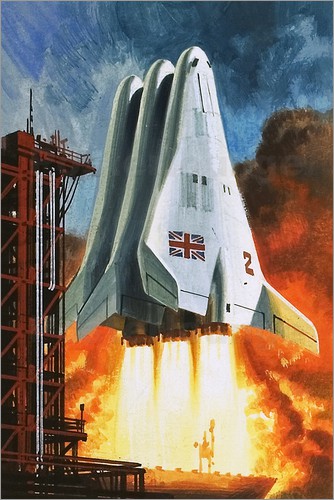
The original project of the MUSTARD British aircraft manufacturer BAC - which involved the launch of three identical vehicles with a total weight of about 424 tons. After a set of 2 km / s and 56 km of altitude, the engines were turned off, and the two extreme vehicles pumped the remaining hydrogen / oxygen fuel into the middle machine, after which they separated and landed like an airplane. The payload was supposed to reach 5 tons, the project did not go beyond the initial design development stage, but received considerable fame in the media.

The British project EAG.4396 provided for the launch of a ship and a rocket stage from an aircraft at a speed of 4M. The rocket stage had kerosene / oxygen and two discharged tanks as fuel. According to the project, different versions of the ship / missile as a carrier were worked out, but because of its military orientation, almost nothing is known about it.
The project “Le transporteur aerospatial” of the French company Dassault Aviation is a ramjet aircraft with a ramjet engine, the acceleration stage and the rocket plane in which hydrogen was to be used as fuel at all stages.
Modern projects
This is the Pegasus XL launch vehicle - it is launched at an altitude of 12.4 km from the modified wide-body passenger aircraft Lockheed L-1011 TRAYSTAR and is a super-light carrier rocket. The weight of the rocket is 23.12 tons, and the payload can reach 443 kg. Since 1990, only 43 missiles of this class were launched, while from mid-2013 Orbital ATK had only 2 contracts with NASA for which the CYGNSS satellite was launched on December 15, 2016, and on December 8, 2017, the ICON satellite should fly already at a price of $ 56.3 million, after which the company has no contracts at all. And this is not surprising: after the launch of SpaceX on the market for tons of cargoes for NASA at a price in the region of $ 87 million , the sense of using Pegasus has practically disappeared. And for commercial customers, which launch on the Falcon 9 rocket costs $ 62 million - Pegas looks even more unattractive.
Launch of 8 microsatellites of 28.9 kg each according to NASA's CYGNSS hurricane tracking mission
Despite this, the company did not abandon its cruise missile and even signed in October 2016 an agreement on their launches from the largest aircraft in the world, the Stratolaunch, which allows carrying 3 Pegasuses in one go. But with the news about the first tests of the rocket “Electron” from the Rocket Lab , the return to the flights of the Japanese SS-520-4 before the end of 2017, the first suborbital flights of the Vector-R and the preparing Firefly Alpha for flights (with the same payload class, but 6-10 times lower cost) - this project has almost no chances.

The project of the Swiss suborbital ship SOAR , using in itself the workings of another European project "Hermes" . It was assumed that the suborbital spacecraft would launch an additional rocket stage (which the RSC Energia was supposed to produce under the contract), which would allow the launch of up to 250 kg into orbit. The first test flights were supposed to start in 2016, but because of financial problems, the company declared bankruptcy by the end of this year. The fate of the project is questionable.
In a separate category include projects SSTO:
This is another promising branch of the development of means of launching into orbit called “single-stage-to-orbit” - one step out into orbit. The main problem with this approach is the need to gain 7.8 km / s orbital speed and 200 km of altitude required for the reference orbit , while the gravitational and aerodynamic losses lead to the fact that such a ship must have a characteristic speed margin of 9-10 km / s.
These are very harsh conditions for a ship with a liquid propellant rocket , as for the most efficient hydrogen / oxygen fuel pair currently in use, it has a specific impulse of 3816 m / s at sea level and 4462 m / s in vacuum - according to the Tsiolkovsky formula should in this situation have an intrinsic mass to fuel mass ratio of about 1:10 or even more - that is, engines, tanks, control system and payload should be less than 10% of mass. At the same time, the mass perfection of modern rockets using aluminum-lithium alloys and carbon fiber reaches 5% of the weight only with kerosene / oxygen components, and in the case of hydrogen / oxygen fuel, this figure is even lower. That is, practically nothing remains on the payload. , — .

X-30 — , 1982-1993 . , — , . - ( ). - — , X-43 X-51 .
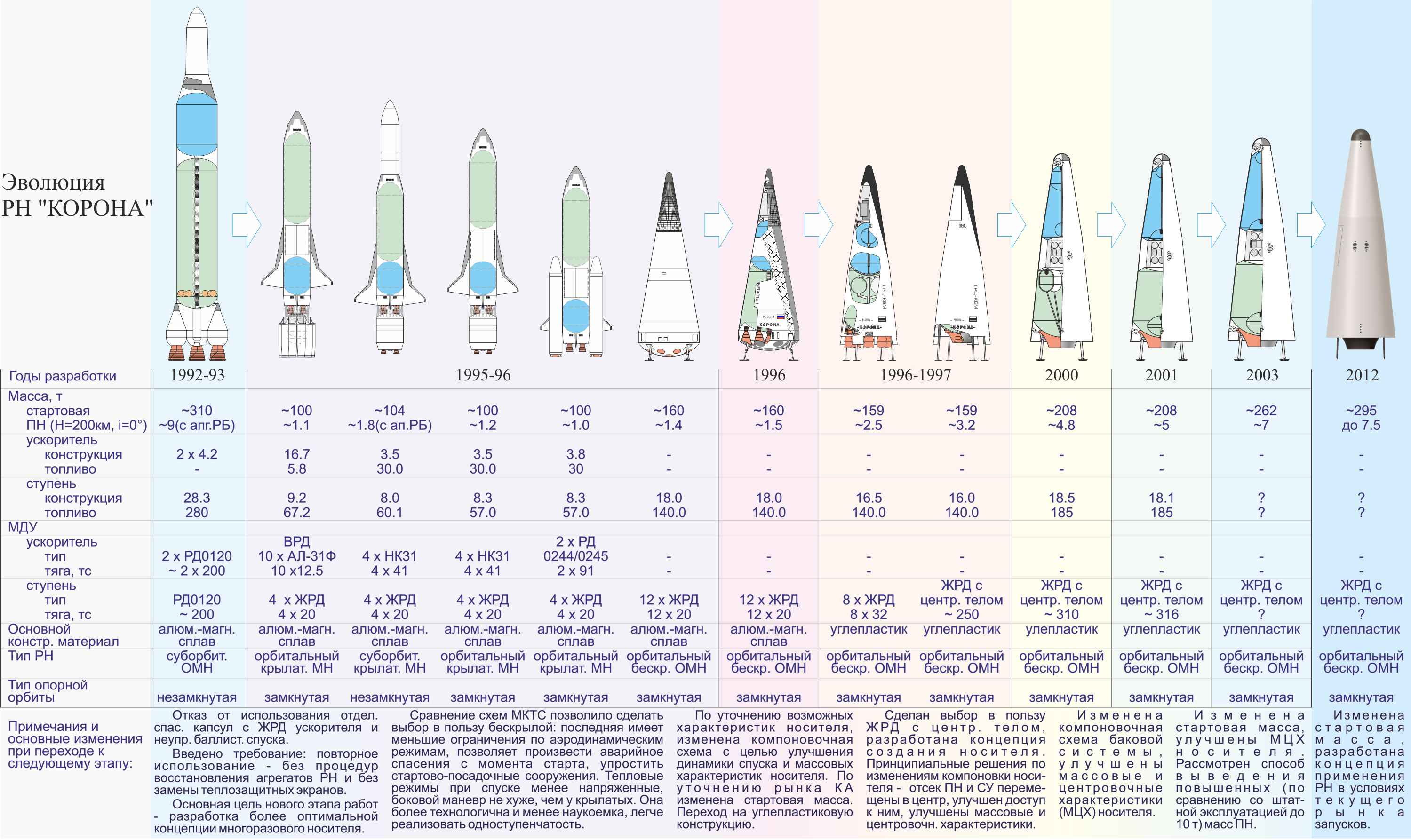
«» « » 1992 2012 — - 300 ( / ) 1 7,5 . 2013 .
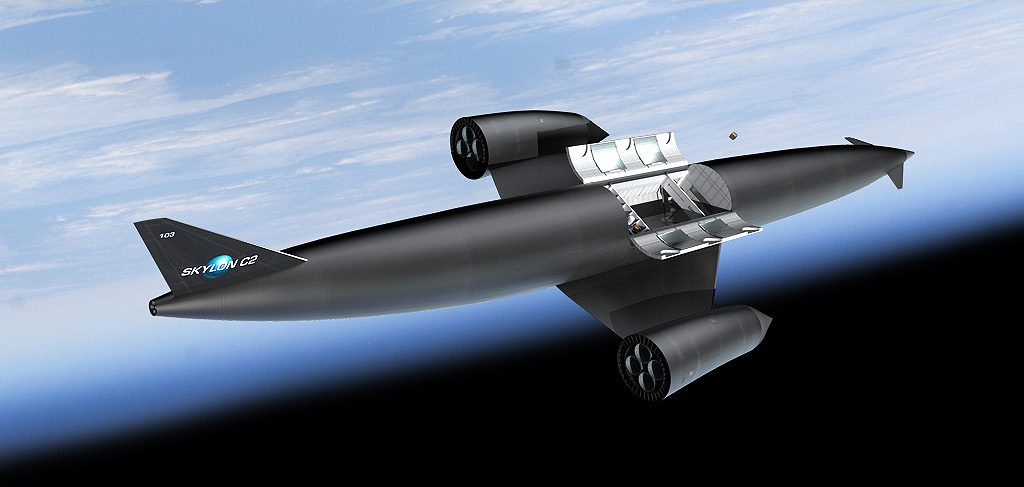
HOTOL 1982 , Skylon 2004 2025 — , 5,4 26 , . 17 7,3 . 12 $, 200 .
« »

DC-X, SSTO « », 18 1993 ( «» SpaceX). 5 , . , (DC-XA) 3- 3140 ( 4 «»), - ( ). 110 $ ( ) — :

X-33, VentureStar
VentureStar — 1992 , : 20 . — X-33 , 2004 . - X-33 , . NASA — . XS-1 DARPA :

PS — « » .. .. , ( X-15 «» ) .
Source: https://habr.com/ru/post/373891/
All Articles